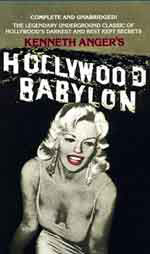
Anger Rising
By Geof Smith
Try as they might, practitioners of the dark arts just don't seem so dark anymore. Thick black eyeliner, pentagram tattoos and
pagan jewelry are just as likely to conjure images of a sulky waitress delivering fried onion appetizers at T.G.I.Fridays as they are a member
of a chanting coven. Nowadays Satanism has been reduced to comic bookish extremes and made de rigueur in heavy metal and goth
circles. But it wasn't always this way. In the late 60s and early 70s, long before iPods made it impossible to play "Hand of Doom"
backwards, pop culture and the dark side often combined in a heady, volatile cocktail. During these rebellious days edgy
experimentation was the norm and wanton paganism was political. Time magazine questioned whether or not God was dead.
The Rolling Stones asked for some "Sympathy for the Devil." Sammy Davis Jr. partied with the head of the Church of Satan,
Anton LaVey. During these times the high priest of troublesome art was Kenneth Anger. Like a demonic Forrest Gump he appeared
time and again intertwining his story with those of Mick Jagger, Jimmy Page, Charles Manson, and Bobby Beausoleil as he tried to
complete his epic experimental film Lucifer Rising.
Prone to mood swings, often combative and a natural born iconoclast, the young artist must have known his given name of
Kenneth Wilbur Anglemyer was not suited for him. He reinvented his last name and quickly became one of the most fiercely
independent experimental filmmakers of the American underground. Though his nine short films barely total more than three hours
of work, he stands alongside Andy Warhol, Stan Brakhage and Bruce Connor in influence.
 At age seventeen, Anger made his first film, Fireworks (1947), with a borrowed camera and a free weekend. Shot in his parents'
home while they attended the funeral of a relative, the 15-minute work shows the rape and molestation of a teenage
boy (played by Anger) by American sailors. It’s dreamlike imagery ends with one sailor opening his pants to reveal a lit Roman
candle. Fireworks is nothing short of revolutionary in an age when gay cinema did not exist and American soldiers were returning
home as heroes. Jean Cocteau invited Anger to France where he spent the next decade as the darling of the European Avant-garde
before eventually returning to America.
At age seventeen, Anger made his first film, Fireworks (1947), with a borrowed camera and a free weekend. Shot in his parents'
home while they attended the funeral of a relative, the 15-minute work shows the rape and molestation of a teenage
boy (played by Anger) by American sailors. It’s dreamlike imagery ends with one sailor opening his pants to reveal a lit Roman
candle. Fireworks is nothing short of revolutionary in an age when gay cinema did not exist and American soldiers were returning
home as heroes. Jean Cocteau invited Anger to France where he spent the next decade as the darling of the European Avant-garde
before eventually returning to America.
Fireworks was followed by a string of increasingly experimental films: Puce Moment (1949), Rabbit's Moon (originally created
in 1950, this would be re-cut and re-scored in 1972 and 1979), Eaux D'Artifice (1953) and Inauguration of the Pleasure Dome (1954).
These nonlinear films explored gay themes and employed occult imagery inspired by Anger’s idol Aleister Crowley, the
turn-of-the-century mystic who is often credited with creating modern Satanism.
 Anger’s next work, 1963's Scorpio Rising, is largely considered the first post-modern film. On the surface it follows a biker named Scorpio through a chaotic series of events that include church
vandalizing, drug taking, partying, homoerotic abuse, and motorcycle fetishization. Though the editing is brisk and jolting,
it is never haphazard; and the resulting collision of images creates associations between Jesus Christ, Hitler, biker gangs,
homosexuality, and comic strips. In short, Scorpio Rising is a jarring critique of American culture. Most notably, Scorpio
eschews a traditional score and uses pop music, introducing the idea of a found score, which would infect mainstream films like
American Graffiti and Mean Streets. It’s not surprising that Martin Scorsese cites Anger as an important influence and considers
him a “unique filmmaker, an artist of exceptional imagination.” It should be noted that Anger used the pop music without
clearances, which led to legal problems that has given this important short film a spotty history on home video.
Though Scorpio Rising would become his most influential film, it is Lucifer Rising that would become, perhaps unintentionally,
Anger’s life work.
Anger’s next work, 1963's Scorpio Rising, is largely considered the first post-modern film. On the surface it follows a biker named Scorpio through a chaotic series of events that include church
vandalizing, drug taking, partying, homoerotic abuse, and motorcycle fetishization. Though the editing is brisk and jolting,
it is never haphazard; and the resulting collision of images creates associations between Jesus Christ, Hitler, biker gangs,
homosexuality, and comic strips. In short, Scorpio Rising is a jarring critique of American culture. Most notably, Scorpio
eschews a traditional score and uses pop music, introducing the idea of a found score, which would infect mainstream films like
American Graffiti and Mean Streets. It’s not surprising that Martin Scorsese cites Anger as an important influence and considers
him a “unique filmmaker, an artist of exceptional imagination.” It should be noted that Anger used the pop music without
clearances, which led to legal problems that has given this important short film a spotty history on home video.
Though Scorpio Rising would become his most influential film, it is Lucifer Rising that would become, perhaps unintentionally,
Anger’s life work.
 Anger planned his next film to be larger in scope, a work directly inspired by and celebrating the writings of Aleister Crowley.
Crowley believed the world was governed by a series of ages represented by different gods and goddesses. The current age of
Jesus Christ, or the Egyptian god Osiris, was coming to an end, and the age of Lucifer, or Horus, was on the rise. Anger
envisioned a film that would mark this change and depict the fallen angel returning to his rightful place as a hero of the heavens.
Unfortunately, his earliest attempt was derailed when the five-year-old boy he wanted to play Lucifer died as the result of a fall
through a skylight. Though the accident was unrelated to the filming, it was an ominous start to a project that would be
repeatedly plagued by problems.
Anger planned his next film to be larger in scope, a work directly inspired by and celebrating the writings of Aleister Crowley.
Crowley believed the world was governed by a series of ages represented by different gods and goddesses. The current age of
Jesus Christ, or the Egyptian god Osiris, was coming to an end, and the age of Lucifer, or Horus, was on the rise. Anger
envisioned a film that would mark this change and depict the fallen angel returning to his rightful place as a hero of the heavens.
Unfortunately, his earliest attempt was derailed when the five-year-old boy he wanted to play Lucifer died as the result of a fall
through a skylight. Though the accident was unrelated to the filming, it was an ominous start to a project that would be
repeatedly plagued by problems.
Anger continued his search for a suitable Lucifer in San Francisco. He moved into a rundown Victorian mansion, painted the
Crowley-ism "Do What Thou Wilt" on the front door, and became a confidant of Anton LaVey. The bald, goateed founder of the
Church of Satan wore devil horns, held black masses, and kept a pet tiger. Even in the intentionally freaky scene of psychedelic
Frisco, Anger and his cohorts were considered out there and a source of bad vibes. But the filmmaker did find his star.
Kenneth Anger met Bobby Beausoleil at an acid-fueled orgy/performance/happening called The Invisible Circus, featuring a
psychedelic band called the Orkustra. Beausoleil was the band's guitarist. He liked the concept for Lucifer Rising and agreed
to star if he could create the music. It all seemed perfect and pre-ordained. Even the names corresponded: Beausoleil meant
"beautiful sun" and Lucifer translates to "bringer of light" or "morning star." Situations were aligning, but the harmony wouldn’t
last long.
 Beausoleil moved into the mansion with Anger. Though the relationship wasn't sexual, it did have aspects of a chicken hawk
and his conquest. The guitarist paid no rent and was given a truck and gifts of jewelry. Work on the film was sporadic and
plagued by budget problems. To generate excitement for the film, Beausoleil and Anger prepared a stage show in September 1967.
The Equinox of the Gods would combine the existing Lucifer footage, music from Beausoleil’s new band The Magick Powerhouse of Oz,
comedy from the hippie troupe Congress of Wonders, and, finally, Anger's summoning of the gods of the equinox. It was during this
Crowley-inspired invocation that the show fell apart. What actually happened is unclear and highly disputed, but Anger blamed his
rising star for intentionally creating the problems and accused him of stealing the "Lucifer" footage. Beausoleil has long denied
both claims.
Beausoleil moved into the mansion with Anger. Though the relationship wasn't sexual, it did have aspects of a chicken hawk
and his conquest. The guitarist paid no rent and was given a truck and gifts of jewelry. Work on the film was sporadic and
plagued by budget problems. To generate excitement for the film, Beausoleil and Anger prepared a stage show in September 1967.
The Equinox of the Gods would combine the existing Lucifer footage, music from Beausoleil’s new band The Magick Powerhouse of Oz,
comedy from the hippie troupe Congress of Wonders, and, finally, Anger's summoning of the gods of the equinox. It was during this
Crowley-inspired invocation that the show fell apart. What actually happened is unclear and highly disputed, but Anger blamed his
rising star for intentionally creating the problems and accused him of stealing the "Lucifer" footage. Beausoleil has long denied
both claims.
Anger and Beausoleil went their separate ways. Beausoleil hooked up with a new band, The Milky Way. Though they only played
one gig, it would be his association with the group's frontman, Charles Manson, which would land Beausoleil in prison for the
rest of his life. After taking a full-page ad in the Village Voice announcing the death of his film career, Anger retreated to
London. With what little film remained from San Francisco, plus some new footage and the help of Mick Jagger, Anger completed
Invocation of My Demon Brother. It is a darkly phantasmagoric brew of imagery accompanied by a Jagger-created Moog dirge. The
experience so disturbed Jagger that he wore a crucifix around his neck for months after the shoot.
Anger's introduction to rock and roll’s elite inspired him to pursue Lucifer Rising again. However, his new associations did
not make the work any easier, and he spent the next ten years toiling in fits and starts. The major issues were casting and music.
After Beausoleil, Anger considered Jagger for his anti-hero. However, Jagger, still reeling from the satanic vibes raised by
My Demon Brother, declined. Anger then hired Jagger's brother Chris. This bit of casting also failed, and the desperate filmmaker
settled on Leslie Huggins, a Middlesbrough steel worker. Marianne Faithfull and Donald Cammel handled the remaining parts.
Anger took his troupe and filmed them performing extravagant ceremonies in a number of magickal locations in London, Germany,
and Egypt.
 Anger thought Led Zeppelin guitarist Jimmy Page would be the perfect composer for his occult masterwork. The two met at a
Sotheby's auction of Aleister Crowley materials. Page was also a longtime devotee of the mystic's teachings and, in fact, one
of his three houses was Crowley's onetime residence at Boleskine on the shores of Loch Ness. Page arranged editing time for
Anger in the same studios where The Song Remains the Same was being finished and began working on an experimental
synthesizer-drenched score. He even arranged for an early screening to present the work-in-progress and generate buzz. Despite
all this Anger ended the relationship and criticized Page's uncommitted dabbling. Page maintained that Anger was actually more
concerned about a troubled book deal he had for his long-suffering tinseltown tell-all "Hollywood Babylon," which publishers
were afraid to release due to possible legal backlash. Now Anger seemed stuck with two foundering projects. However, whenever
Anger closes a door, the devil seems to open a window.
Anger thought Led Zeppelin guitarist Jimmy Page would be the perfect composer for his occult masterwork. The two met at a
Sotheby's auction of Aleister Crowley materials. Page was also a longtime devotee of the mystic's teachings and, in fact, one
of his three houses was Crowley's onetime residence at Boleskine on the shores of Loch Ness. Page arranged editing time for
Anger in the same studios where The Song Remains the Same was being finished and began working on an experimental
synthesizer-drenched score. He even arranged for an early screening to present the work-in-progress and generate buzz. Despite
all this Anger ended the relationship and criticized Page's uncommitted dabbling. Page maintained that Anger was actually more
concerned about a troubled book deal he had for his long-suffering tinseltown tell-all "Hollywood Babylon," which publishers
were afraid to release due to possible legal backlash. Now Anger seemed stuck with two foundering projects. However, whenever
Anger closes a door, the devil seems to open a window.
In 1976, Bobby Beausoleil was doing time at Dueul Correctional Institute when he learned of the problems between Anger and Page.
He still yearned to create the music for Lucifer Rising. His sentence had been commuted to life when California did away with
the death penalty and he needed a project that would not only pass the time, but fill his life with a positive, creative release.
He needed to prove that he was not dead or destroyed. He contacted Anger and arrangements were made with Warden R.M. Dees.
 Beausoleil viewed a rough cut of the movie in the prison chapel and instantly connected with its images of exile, pain and
redemption. He recruited a band of inmates, which he christened the Freedom Orchestra, and began working with homemade instruments.
Beausoleil took an electronics course through a community college and built his own synthesizers. When prison rules forbade
him from having more than one instrument at a time in his cell, Beausoleil designed a combined bass and guitar. Complicated by
the paroles and transfers of band members and the occasional lockdown, it took Beausoleil three years to complete the soundtrack.
In 1980 he sent the finished work to the director. With his epic project finally finished, Anger realized that Beausoleil had
always been the one true Lucifer for his project.
Beausoleil viewed a rough cut of the movie in the prison chapel and instantly connected with its images of exile, pain and
redemption. He recruited a band of inmates, which he christened the Freedom Orchestra, and began working with homemade instruments.
Beausoleil took an electronics course through a community college and built his own synthesizers. When prison rules forbade
him from having more than one instrument at a time in his cell, Beausoleil designed a combined bass and guitar. Complicated by
the paroles and transfers of band members and the occasional lockdown, it took Beausoleil three years to complete the soundtrack.
In 1980 he sent the finished work to the director. With his epic project finally finished, Anger realized that Beausoleil had
always been the one true Lucifer for his project.
After more than ten years of false starts and tribulations, could the completed Lucifer Rising measure up to all that had come
before it? It runs only forty-five minutes, and though much of the imagery is arresting and the associative editing is often
powerful, the times and his very innovations seem to have caught up with the bad boy auteur. In a world bloated with quick
cutting and garish pop visuals, Lucifer Rising seems too much like a really weird music video today. Instead of ushering in a
new age of gods and cinema, it looks quaintly trippy and out of date, like those distracting fantasy sequences in
The Song Remains the Same. The most potent element of the piece is Beausoleil's music. It too seems to be from another
time, perhaps something from Pink Floyd's Saucerful of Secrets, but the moody, garage-tinged dirges and marches are filled with
real passion and triumph. They are the pulse and life of Anger's story. Luckily the complete score is now available on a two-CD
set that also includes Beausoleil’s early soundtrack demos from San Francisco.
With twenty years of perspective, Lucifer Rising seems less like The Lawrence of Arabia of experimental films and more
like the Heaven's Gate—a well-executed, sometimes compelling, sometimes baffling closure to a time and movement. Today Kenneth
Anger oversees his legacy and gives combative interviews, where he is happy to sound like an irascible old queen who enjoys
dishing the dirt on celebrities. He is not impressed that he is a revered influence because it has done little for him financially.
Instead he looks at the pop-centric world his films helped to usher in and the tabloid culture his "Hollywood Babylon" inaugurated,
and finds little joy. Crowley’s vision for the age of Lucifer was a time when people would question antiquated mores and embrace
what had been considered vulgar. Perhaps, in some dim way, Anger sees this occurring around him, and, as with most deals with the
devil, the result isn’t as satisfying as expected.
|



















































